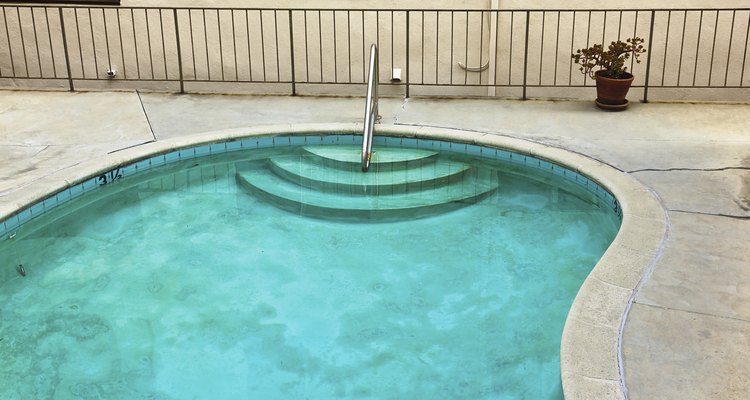
Johnny Habell/iStock/Getty Images
Beneficial to life, algae is possibly the most important organism on earth. They provide 70 to 80 percent of the planet's oxygen, according to Ecology.com. However, you don’t want them in your swimming pool. Algae in your pool can not only be unsightly, but can cause negative health problems.
Causes
Most problems related to algae in swimming pools occur as a result of improper maintenance and chemical use. A correctly sustained balance of chlorine and pH levels is necessary to disinfect pools and kill organisms. Signs of algae infestation range from cloudy-looking water, clear slippery slime on pool steps and walls, hard black growth on liners, to the dreaded green swamp appearance.
Types

Identification of algae types is assessed by their color. Green algae are the most common and the easiest to eliminate. Yellow or mustard-colored algae is more difficult to remove but does respond to most algaecide treatments. Black algae tend to be the hardiest, especially in plaster or cement pools.
Growth
Algae require food to grow. Phosphates and nitrogen can provide this source. You shower before entering a pool because dead skin cells can provide a source of phosphates. Yard care products often contain both phosphates and nitrogen and can be tracked into a pool easily from your lawn, or blow in with grass clippings. Urine, containing ammonia comprised of nitrogen and hydrogen, is a perfect food for algae. When sources of nitrogen enter the water, they combine with oxygen supplied by the chlorine, creating nitrates. This results in a chlorine deficiency encouraging the growth of more algae.
Problems
Algae, although unsightly, will not hurt you. However, bacteria feeding on algae waste becomes a problem. Bacteria multiple in the heated environment of a swimming pool, and swallowing, breathing or coming in contact with these germs can lead to many illnesses. Some of the most encountered problems are gastrointestinal illnesses, like E.coli and Giardia, rashes, skin lesions and other dermal infections, respiratory infections and swimmer's ear.
Prevention and Treatment
Maintaining a chlorine level of between two and three parts per million will stop the onset of an algae bloom in your pool. The plant still exists but it won’t have the ability to grow and multiply. According to TPS, green algae can be killed by super chlorinating, raising the level of chlorine in your pool to about 30 parts per million. After 24 to 48 hours, a good vacuuming and back flushing of the filter system will clean up all the dead cells. Then check and adjust the pH levels. Yellow and black algae require scrubbing with a stiff brush, then using a concentrated algaecide or chlorine tablets to spot treat residual algae.
Precautions
Chemicals used in pool care are highly corrosive and toxic and should stored and handled with care. When in doubt always follow directions on labels and seek professional assistance.
Related Articles

Skin Problems Caused by Swimming Pool ...

Sunburn & Chlorine Pool Swimming

How to Get Rid of Skin Mildew

How to Keep Mosquitoes Away When ...

Egg Whites & Potassium

Potassium Permanganate to Wash ...

Why Does the Hair Fall Off of Your ...

Why Should You Use Filtered Water in a ...

How to Dye Black Fabric Green

How to Clean the Green Discoloring on ...

Homemade Solution for Killing Bacteria ...

Facts About Orphans

How to Whiten Mesh Sneakers

How to Remove Chlorine From Color ...

How Do Yellow Lenses in Ski Goggles ...

Should You Steam or Blanch Bean Sprouts ...

Subungual Warts and Treatment

How to Know When Sprouted Garbanzo ...

Safety Hazards of Acetone

Why Do White Clothes Turn Yellow in ...
References
Writer Bio
Gord Kerr's professional background is primarily in business and management consulting. In 1991, Kerr started writing freelance for a small local newspaper, "The Summerland Review," and a leading sailing publication, "Cruising World Magazine." Kerr has a Bachelor of Business Administration degree from Wilfred Laurier University.
Photo Credits
Johnny Habell/iStock/Getty Images